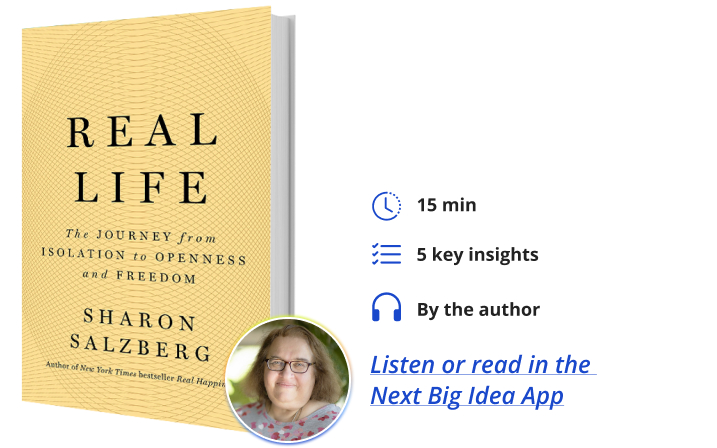Sharon Salzberg is a teacher of Buddhist meditation and the author of twelve books, including the New York Times bestseller, Real Happiness, now in its second edition, and her seminal work, Lovingkindness. She is a co-founder of Insight Meditation Society, and an internationally recognized speaker, having sat on panels alongside the likes of the Dalai Lama.
Below, Sharon shares 5 key insights from her new book, Real Life: The Journey from Isolation to Openness and Freedom. Listen to the audio version—read by Sharon herself—in the Next Big Idea App.

1. Contraction limits creativity and connection.
Contraction (or constriction) isn’t the same as focusing or being one-pointed, centered, or contained. We can be specific, determined, and intentional without being constricted. Think of the last time you were lost in fear or were harshly unforgiving of yourself or when you felt a craving so strong that all reason and common sense fled (remember old infatuations, for example). Or consider the last time any sense of potential change collapsed, and you fell into hopelessness.
There are moments when we experience limited options, the blunting of our creativity, a feeling of disconnection, or the dimming of our vision of what is possible. It’s not to say that contraction is bad or wrong to feel. But if it becomes a steady state, we begin living more and more in a world of tunnel vision, auditory exclusion, distorted perception, narrowed interests, of joy that is right here in front of us that we miss simply because we don’t see it. Our perception of options, possibility, of aliveness, fades. And we suffer.
2. Happiness isn’t where you thought it would be.
Years ago, I was traveling back to the East Coast from New Mexico with some friends and their four-year-old child, who wandered off in the St. Louis airport and got lost. When we finally found the child, thanks to a kind staff member, the child was very upset and frightened and said accusingly to her mother, “You weren’t where you were supposed to be.” Of course, her mother had never left where she was supposed to be; the child herself had wandered off. This incident reminds me of the sense of betrayal and fear we can feel when we discover that perfect happiness isn’t where we had expected it to be.
“You may find that it’s society’s prescriptions for freedom, happiness, and abundance that bind us most severely.”
So, become curious and investigate where you’re looking for happiness. You may find that it’s society’s prescriptions for freedom, happiness, and abundance that bind us most severely. Questioning releases us from the grip of past perspectives or from projecting our fears into a seemingly unchanging future, or from making choices based on a long-ago determination that we don’t deserve to be happy. Questioning frees and opens us to discovery.
3. Loving presence transforms our relationship with painful emotions.
Kate Braestrup serves as a chaplain to search and rescue workers in Maine. She recounts being called out to sit with the parents of a missing six-year-old child (later found alive after many hours lost in the woods). The little girl’s mother said to her, “It’s so cool that the warden service has a chaplain to keep us from freaking out.”
Braestrup responded, “I’m not really here to keep you from freaking out. I’m here to be with you while you freak out.”
Braestrup knows that as a chaplain, it’s not her job to take people’s suffering away. Instead, she says, “I am there if they want to grieve or laugh or suffer or sing. It is a ministry of presence. It is showing up with a loving heart.”
“Instead of demanding that a painful emotion disappear or becoming all consumed by it, we begin to relate to our experience with spaciousness infused with kindness.”
Many healing modalities, such as mindfulness meditation, are designed to cultivate a ministry of presence for ourselves—a space of forgiveness, compassion, and openness in the face of inner pain. This can be summed up as love. I most often think of love as a visceral, embodied knowing of connection—with ourselves, with another, with life.
Instead of demanding that a painful emotion disappear or becoming all consumed by it, we begin to relate to our experience with spaciousness infused with kindness. We begin to relate to ourselves with love, whatever we are going through. While we can’t control life, we begin to effect change by profoundly transforming the space in which the pain we feel is held.
4. Cultivating positive states creates resilience.
Author and activist Sojourner Truth said, “Life is a hard battle anyway. If we laugh and sing a little as we fight the good fight of freedom, it makes it all go easier. I will not allow my life’s light to be determined by the darkness around me.”
This quote reminds me that a primary ingredient in transforming our relationship to painful experiences is to have enough light to surround the darkness, a space big enough to hold the pain and not collapse into it. We can cultivate that space by practicing positive states such as gratitude, awe, serenity, hope, or loving-kindness. According to researcher Barbara Fredrickson, who specializes in positive states, these qualities broaden our scope of awareness so we can experience a wider array of thoughts, actions, and perceptions. They also build a sense of inner resource and available strength. This gives resiliency to meet life, come what may.
5. We find ourselves through connecting with others.
When we connect with others, we don’t lose ourselves, we find ourselves. In those moments, we find the voice within that isn’t overcome by fear (though that may be in the room) or by unworthiness (though that may be there too). We find the voice born of recognizing a bigger sense of possibility, which urges us to engage without the certainty of definite, immediate reward. This is what gets us out of bed, out of lethargy, to see if life can be different. Connecting to one another is the dynamism that reminds us continually to affirm what might yet be rather than allowing discouragement or anxiety to lay waste to any sense of that vision.
“We are capable of not only the greatest wrongs but also the highest good.”
We can experience a power of connection that is alive and responsive: our hearts tremble or we have a clear intuition as to how a conversation may look from someone else’s perspective, or we recognize for a moment that this person wants to be happy just as we do, that they have their own story and hopes and fears and dreams.
We respond more and more from that place of connection, rather than the fears and divisions and preconceptions that beset us. We are capable of not only the greatest wrongs but also the highest good. Many days, we face the direct question of what will get us to reach for the highest.
To listen to the audio version read by author Sharon Salzberg, download the Next Big Idea App today:





























